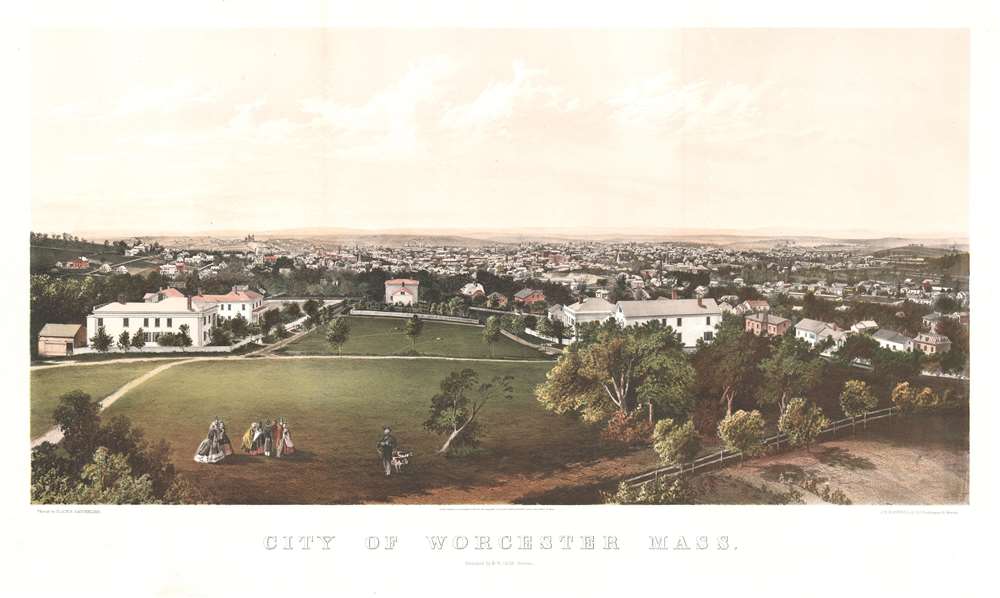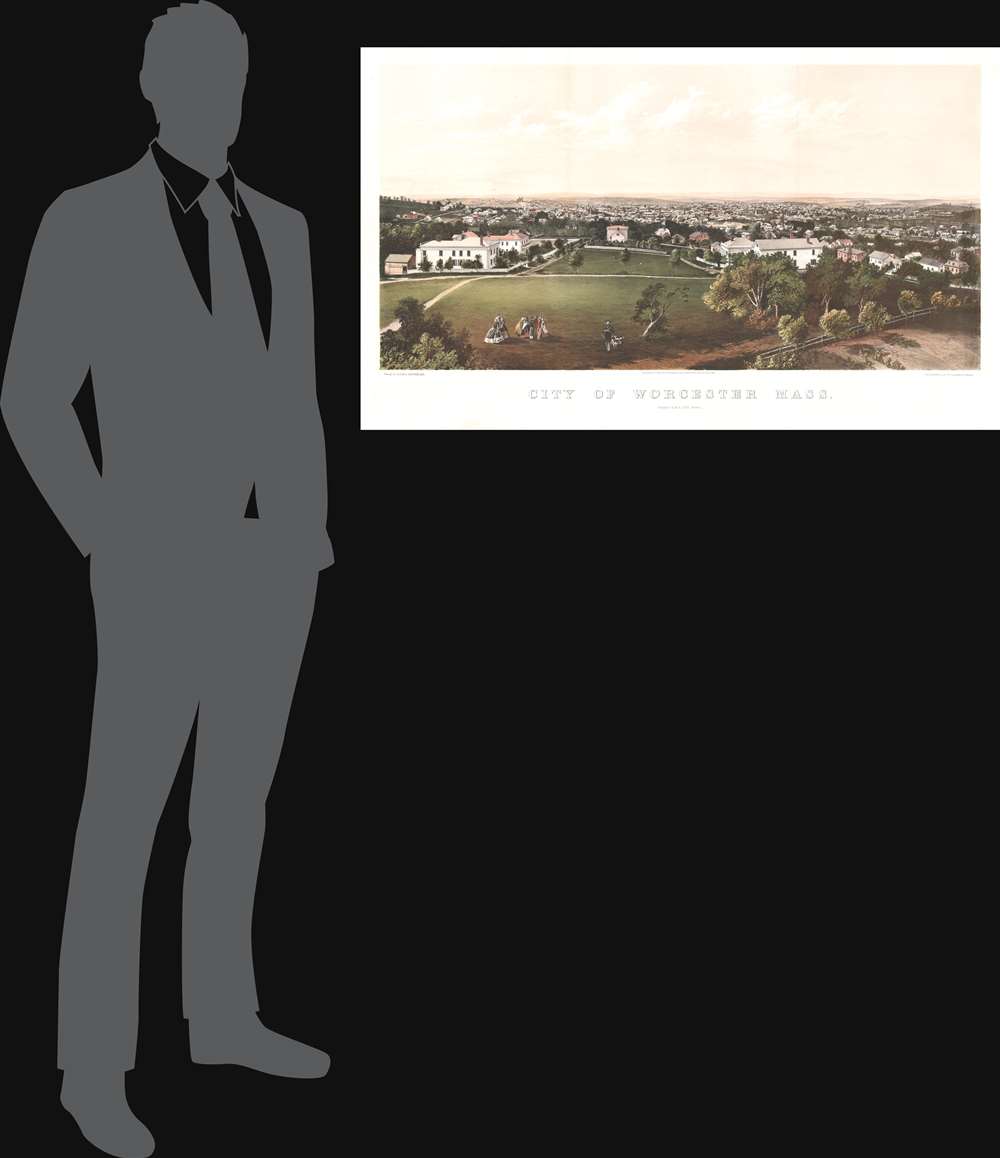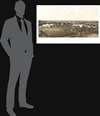This item has been sold, but you can get on the Waitlist to be notified if another example becomes available, or purchase a digital scan.
1864 Bachelder / Tarr View of Worcester, Massachusetts
Worcester-tarr-1864
Title
1864 (dated) 20 x 33.5 in (50.8 x 85.09 cm)
Description
A Closer Look
The view is somewhat difficult to parse. The row of industrial buildings in red at center may reflect Main Street. The depression just to the right of center is likely Bell Pond. Grandiose estates and a spacious lawn dominate the foreground.American Bird's-Eye City Views
The tradition of the bird's-eye city view emerged in the United States in the middle part of the 19th century and coincided with the commercial development of lithographic printing. Before the rise of lithography, the ability to own and display artwork in the home was largely limited to the extremely wealthy. The advent of lithographic printing made it possible for everyone to own visually striking artwork. A robust trade developed in portraits of political leaders, allegorical and religious images, and city views.City views were being produced in the United States as early as the 1830s, but the genre exploded after the American Civil War (1861 - 1865). Bridging the gap between maps and pictures, most 19th-century American bird's-eye views presented cities to the public from high vantage points. Some were imagined, but others were drawn from hot-air balloons or nearby hills. The presentation, combining high elevation, commercial interest, and new printing technology, created a uniquely American art form, as described by historian Donald Karshan
Some print connoisseurs believe that it was only with the advent of the full-blown city-view lithograph that American printmaking reached its first plateau of originality, making a historical contribution to the graphic arts. They cite the differences between the European city-view prints and the expansive American version that reflects a new land and a new attitude toward the land.The vogue for bird's-eye city views lasted from about 1845 to 1920, during which period some 2,400 cities were thus portrayed, some multiple times. Although views were produced in many urban centers, the nexus of view production in the United States was Milwaukee, Wisconsin. The major American viewmakers were Stoner, Wellge, Bailey, Fowler, Hill, Ruger, Koch, Burleigh, Norris, and Morse, among others.
Chromolithography
Chromolithography, sometimes called oleography, is a color lithographic technique developed in the mid-19th century. The process involved using multiple lithographic stones, one for each color, to yield a rich composite effect. Oftentimes, the process would start with a black basecoat upon which subsequent colors were layered. Some chromolithographs used 30 or more separate lithographic stones to achieve the desired product. Chromolithograph color could also be effectively blended for even more dramatic results. The process became extremely popular in the late 19th and early 20th centuries when it emerged as the dominant method of color printing. The vivid color chromolithography produced made it exceptionally effective for advertising and propaganda imagery.Publication History and Census
This view is based upon a photograph by James Wallace Black and Perez Mann Bachelder. It is often erroneously associated with J. B. Bachelder, of Gettysburg fame, who also made views of New England towns but is unrelated. It was printed in Boston in 1864 by John Henry Bufford for D. B. Tarr. It is scarce. We note examples at the American Antiquarian Society and the Chicago Historical Society.CartographerS
Perez Mann Bachelder (December 31, 1818 - January 25, 1873) was an early American photographer active in the Mid 19th century. Perez was born in Beverly, Essex County, Massachusetts. Little is known of his early life, but by the 1850s, he was an itinerant photographer in California capturing the Gold Rush. In 1854, following the gold rushes, he moved to Victoria, Australia, opening a daguerreotype saloon in Melbourne (57 Collings Street East). He quickly became the most prominent photographer in Melbourne, operating in partnership with Daniel O'Neill as 'Bachelder and O'Neill's Daguerreotype and Collondian Portrait Rooms'. After considerable success in the Outback, he returned to Boston in 1860, where he opened a study with James Wallace Black (1825 - 1896). The firm lasted until 1866, after which it was sold to F. A. Dunn, J. Botterill, and J. N. Wilson. Bachelder himself moved to San Francisco, where he died in 1873. The firm bearing his name persisted until 1895 under W. J. Stubbs. More by this mapmaker...
James Wallace Black (February 10, 1825 - January 5, 1896) was an American photographer based in Boston in the mid-19th century. Black was born in Francestown, New Hampshire. He made a name for himself as a photographer in partnership with John Adams Whipple (1822 - 1891), the first American to manufacture daguerreotype chemicals. He is most famous for his 1859 portrait of abolitionist John Brown and his 1860 photograph of Walt Whitman. Also in 1860, using a balloon over Boston, his took the first aerial photographs in the United States. Also in 1860, he established a daguerreotype business with Perez Mann Bachelder (1818 - 1873), 'Bachelder and Black'. Black later became known for his magic lantern slides, including important photographs of the Great Boston Fire of 1872. Learn More...
John Henry Bufford (July 27, 1810 - October 8, 1870) was a Boston based lithographer and printer. Bufford was born in Portsmouth, New Hampshire. He apprenticed as an artist and lithographer at Pendleton Lithography (1825 - 1836) of Boston. In 1835 he relocated to New York where he took independent commissions from George Endicott and Nathaniel Currier, among others. Returning to his hometown of Boston in 1839, he took a position of chief artist with the firm of Benjamin W. Thayer, heir to Pendleton Lithography. He probably married Thayer's sister, Anna Melora Tufts Thayer (1808-1878). Bufford has been highly criticized as an engraver, with one historian, David Tatham, stating he had 'a mediocre sort of craftsmanship at best' and 'no very special skills as an original artist.' We, however, find no justification for this harsh criticism. Instead Bufford gravitated toward business and management. By 1844 Thayer's shop was renamed J. H. Bufford and Company. The firm specialized in decorative sheet music, panoramic views, illustrations for books, retractions of paintings, and commercial printing. Bufford is credited with being one of the first employers and mentors of the important artist and engraver Winslow Homer. Bufford died in 1870, passing on the business to his sons Frank G. Bufford and John Henry Bufford Jr. These young men, operating under the imprint of 'J.H. Bufford's Sons, Manufacturing Publishers of Novelties in Fine Arts', expanded the firm with offices in New York and Chicago. A possibly related lithographic printing firm named Bufford Chandler was incorporated in Boston in 1893. It later relocated to Concord, New Hampshire but closed in 1925 when its state business charter was repealed. Learn More...




